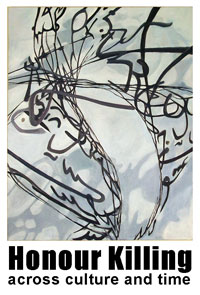
The ANU advertises a forthcoming conference:
Honour Killing Across Culture and Time
Australian National University, Canberra, Australia, 8-9 December 2011
Call for Papers
Honour-motivated violence is a trans-historical and cross-cultural phenomenon, yet it has recently become a metonym for Islamic and anti-modern cultures.  How can inter-disciplinary conversations unpack this association to produce innovative ways of thinking about and acting against violence justified through claims of honour?
How can inter-disciplinary conversations unpack this association to produce innovative ways of thinking about and acting against violence justified through claims of honour?
This conference will explore honour killing across periods, places, political contexts, legal regimes and religions. It will bring together scholars, artists and activists addressing such questions as:
-
How is honour embodied and performed in ways that lead to gendered violence?
-
How are concepts of honour and shame invoked in acts of violence, their justification, and adjudication?
-
Through what behaviours, relations, and authorities has honour-related violence been codified and challenged?
-
How do status anxieties and social asymmetries contribute to honour killing?
-
How do anti-violence strategies negotiate competing claims of human rights and cultural relativism?
-
What are the implications of addressing honour killing as a species of domestic violence?
-
How are personal and familial honour-related killings distinguished from collective, public and state violence?
-
Under what historical circumstances, and through what strategies, have honourable masculinity and violence been dissociated?
-
Can honour be reconceptualised in ways that challenge violent practices justified in the name of honour?
Abstract deadline: 1 August 2011
Scholars, artists and activists are welcomed as presenters.
…
Participants are encouraged to seek their own funding for travel and accommodation.
Source: ANU, School of History website
Artist statement by Conference logo designer:
Through the interactive nature of my installations, sculptures, and textual drawings, I pose questions for each culture to examine from their own perspective: Considering that there is a figure but no embodied form showing, can this be called contemporary figurative Islamic Art? Do these life-size veiled figures threaten or confuse non-Muslim Westerners and why? Recognizing that this work represents women’s freedom to think, can this work be called a universally Feminist art?
Source: Artist’s website
 Sign In
Sign In 0 Items (
0 Items ( Search
Search









